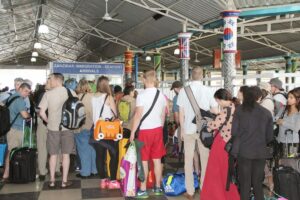
Dar es Salaam, Tanzania.
Tanzania’s pension funds, the Public Service Social Security Fund (PSSSF) and the National Social Security Fund (NSSF), have invested trillions of shillings in loss making high-rise buildings due to lack of tenants, the latest audit report has noted
The 2021/22 audit report by the Controller and Auditor General (CAG) shows that the buildings have higher operational costs than the profit they make through services offered.
According to the report, the economic occupancy rate for well-managed buildings is at least 90 per cent.
The Water Front Tower has an occupancy rate of just 15 percent, while the Julius Nyerere Pension Tower has a 75 percent occupancy rate, according to the CAG’s 2021/22 report.
The average occupancy rate of PSSSF’s buildings was just 21 percent in 2021/22 and the economic occupancy rate for well-managed buildings is at least 90 percent.
For instance, the PSSSF’s Twin Tower in Dar es Salaam has spent Sh245.65 million on operations, while the collections from the service fee are Sh96.81 million.
The other building is the Golden Jubilee Tower in Dar es Salaam city centre, which spent Sh226.97 million for operation, while service fee collections were Sh196.73 million.
PSSSF also recorded losses in its Kaloleni and Mikocheni apartments while making profits in the buildings of Masaki apartments and PSSF International House.
Other loss making PSSSF buildings are Sokoine Mtwara building, Jacaranda, Haile Selassie, Millennium Tower II, Victoria House, PSSSF Commercial Complex, PSSSF Arusha House, and PSSSF Victoria House.
“The increase in building operating costs was caused by the unsatisfactory collection of service fees and the decrease in the number of tenants in the buildings.”
“The audit analysed the financial year of the Social Security Fund for Public Servants from the years 2018/19 to 2020/21 and revealed that real estate investment had an average return on investment of 2.66 percent, compared to 2.67 percent of investment in stocks and 9.28 percent in the financial market,” the report states.
In another development, the report has revealed that the Prime Minister’s Office- Youth Employment, Employment, and People with Disabilities docket did not conduct an investigation audit for the PSSSF and NSSF for the year 2021/22, while in 2020/21 it conducted an audit with an investigation for the PSSSF only.
“Furthermore, the Office of the Prime Minister – Youth Work, Employment, and People with Disabilities could not carry out monitoring activities as it should for the period reviewed from the financial year 2019/20 to 2021/22,” the CAG says in the report.
When contacted, one of the senior PSSSF officials, who did not want to be named, said that the only person who can give details on that matter is the Prime Minister’s Office, when responding to the report in parliament.
However, he pointed out, various efforts have been made to ensure that the investment they made is productive for the members.
“From last year until now, we have made great progress, the investments we made are starting to grow slowly, let’s wait for the time to answer the arguments,” he said.
Share this news
This Year’s Most Read News Stories

The reason internet speeds in Tanzania still lag behind
Vodacom Tanzania was placed 16th at 17. ’08 Mbps, while Airtel Tanzania was ranked 18th available on 12. 89 Mbps.Continue Reading

Concerns mount over Zanzibar new $44 travel insurance fee
Tour operators, hoteliers, tourists, and tourism stakeholders are raising alarms over Zanzibar’s new mandatory $44 travel insurance fee, set to take effect on September 1.Continue Reading

Tanzania readying to talk to British developer over Zanzibar land lease revocation
Dar es Salaam. British firm Pennyroyal Limited has said it will sue the Tanzanian government over leasehold revocation in Zanzibar, but the Attorney General has confirmed that they are preparing to meet with the investor.Continue Reading










